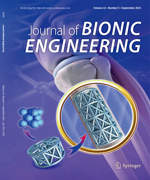|
|
A Bio-inspired Soft Robotic Arm: Kinematic Modeling and Hydrodynamic Experiments
Zheyuan Gong, Jiahui Cheng, Xingyu Chen, Wenguang Sun, Xi Fang, Kainan Hu, Zhexin Xie, Tianmiao Wang, Li Wen*
Journal of Bionic Engineering. 2018, 15 (2):
204-219.
DOI: https://doi.org/10.1007/s42235-018-0016-x
Soft robotics has several promising properties for aquatic applications, such as safe interaction with environments, lightweight, low cost, etc. In this paper, we proposed the kinematic modeling and hydrodynamics experiments of a soft robotic arm with 3D locomotion capacity. We developed a mathematical model that incorporates the angle correction, as well as the open-loop model-based motion control. The model could precisely predict the three-dimensional (3D) movement, and the location error is less than 5.7 mm in different attitudes. Furthermore, we performed the hydrodynamic investigations and simultaneously measured the hydrodynamic forces and the wake flows at different amplitudes (50 mm, 100 mm, 150 mm, 200 mm) and frequencies (0.3 Hz, 0.4 Hz, 0.5 Hz) of the soft arm. Surprisingly, we found that the magnitudes of the hydrodynamic force (<1 N) and the torques (<0.08 N•m) of dynamically moving soft arm were tiny, which leads to negligible inertial effect for the underwater vehicle than those of the traditional rigid underwater manipulator. Finally, we dem-onstrated underwater picking and placing tasks of the soft manipulator by using a computer program that controls the tip attitude and velocity. This study may inspire future underwater manipulators that have properties of low-inertial, low power cost and can safely interact with the aquatic environments.
Related Articles |
Metrics
|

 Table of Content
Table of Content
 Table of Content
Table of Content